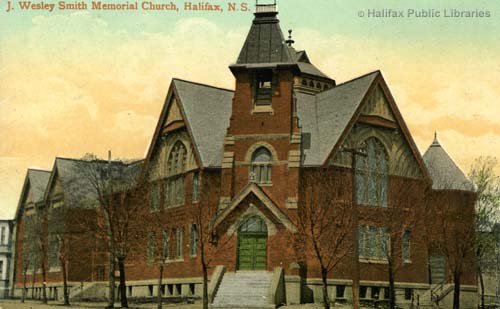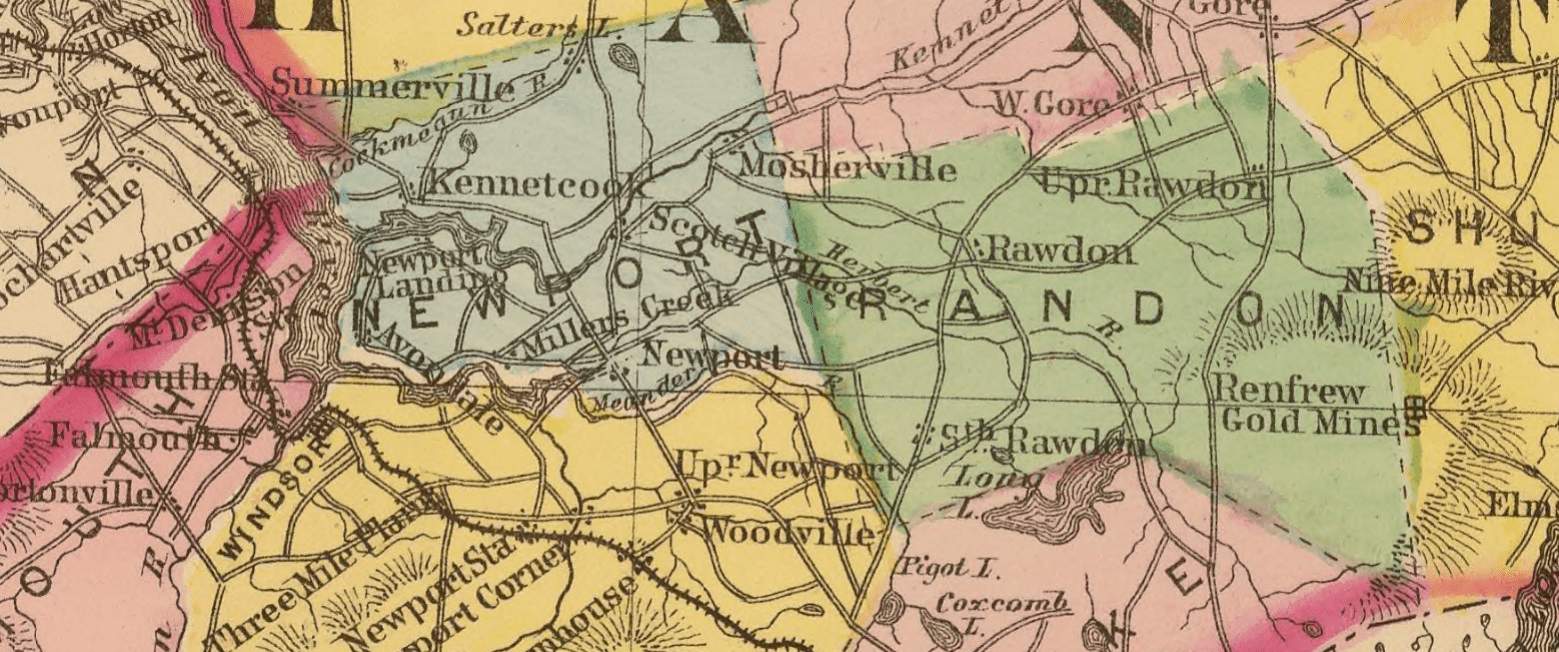Written by Vicky, staff member, Halifax Central Library, opens a new window
Halifax's history is a mosaic of people with their own unique stories and experiences. Some of these people have become household names achieving notoriety for some great deed, or amazing success. But most people, for lack of a better term, would be considered “ordinary.” They lived regular lives, working hard to provide for their families, finding joy in contributing to their community in whatever way they could, and in doing so, helped build our city into what it is today. Let’s take a look at some of these regular people, and what we can learn about their lives in Halifax.
Hugh Brown Jr.
It is uncertain exactly when William Brown (1778-?) immigrated to Newport, Nova Scotia from Northern Ireland. What is known, is that William worked as a farmer and that sometime prior to 1800, he met and married Margaret Ann Smith (1777-?) who was also from Northern Ireland. Together they had at least five children, though some resources list as many as eight. Their oldest child was Hugh Sr. (1800/1806-?) who was born in Newport, and followed in his father’s footsteps working as a farmer.
Quite late in life compared to many of his contemporaries, Hugh Sr. married Margaret Card (1821-1892) from Kempt, Nova Scotia. She was the daughter of Job Card (1776-1868) and Amy Card (Harvie) (1784 -?), both of whom were born in Hants County. They had two children together: Sarah, or Sally (1847-1917), and Hugh Jr. (1854/1857-1913).
Hugh Sr. and his family did not live their whole lives in Newport. From at least 1870, the Browns lived in Halifax on the Northwest Arm Road. The 1871 Canada Census lists Hugh Sr. as a farmer, but the city directory from that period specifies that he worked as a milk dealer. Hugh Jr., who would have been around 14 at this time, was listed as attending school.
Religious life
The Brown family were Wesleyan Methodists, a branch of Christianity that is named after both its founder John Wesley (1703-1791), and the methodical approach of the religion's beliefs and studies. Though several Methodist churches were present in Halifax at this time, Hugh Jr. is specifically noted as a member of the Wesley Smith Memorial Church, currently known as the All Nations Christian Reformed Church at the corner of Robie and Charles Street.
Family life
By 1874, the family had moved to Kline Street where Hugh Jr. was working as a farmer alongside his father. However, subsequent editions of the city directory list Hugh Jr. as a general labourer, or a teamster. This was perhaps done to help differentiate the two Hughs, as additional documentation from this period record Hugh Jr. as a dairyman just like his father.
Whatever his employment, Hugh Jr. would soon be doing it to support a special person in his life. On August 25, 1879, Hugh Jr. was married to Mary Frances Power (1854-1935) of St. John’s, Newfoundland. Her parents were John (1815-1875), a fisherman by trade who died at sea near Indonesia, and Roseann (Ann) Phalen (1823-1887). Hugh Jr. and Mary were wed by Reverend Stephen Huestis, and the marriage was witnessed by Ephriam Card, Hugh Jr.’s uncle, and Charles H. Huestis, the Reverend’s teenage son.
For several years, both Hugh Jr. and his father’s household moved around the city. Hugh Sr. lived on Cunard Street, Chebucto Road, Gottingen Street, and Agricola Street, while Hugh Jr. was never far away, lodging on Bauer Street, Quinpool Road, Chebucto Road, Creighton Street, and Gerrish Street. However, around 1884 there is a distinct change in the Halifax city directories, where Hugh Sr. and Hugh Jr. are no longer listed side by side. Only one Hugh Brown remains, and he is a milkman listed at Hugh Jr.’s address of 99 Gerrish Street. In all likelihood, this is a sign that Hugh Sr. had passed away, and that his son had officially taken over the business.
The family business
Within a year of his father’s death, Hugh Jr. would move his milk business back to Agricola Street, very near to his father’s old location. The family would stay there for a short time, but would ultimately move again. By 1891, the Brown’s milk business had found a home on Kempt Road on the corner of McCully Street. This address may sound strange when considering the modern layout of the city, but this area of what we now know as Robie Street was considered a part of Kempt Road until approximately 1909. When that change was made, the Brown’s address would become 619 Robie Street. Using modern landmarks, the property would have been part of the Colonial Honda dealership.
The Browns took a chance in the mid-1890s and invested in something new and exciting: they got a telephone. Though long-distance communication by telegraph had existed since the 1830s, the telephone had only been around for about 20 years and was still very much in its infancy in terms of widespread use. As of 1888, there were only about 1200 users in both Nova Scotia and New Brunswick combined! The Bell Telephone Company of Canada had established itself in Halifax early on, but sold its interests to the province in the late 1880s. This means that the Brown’s telephone was likely serviced by The Nova Scotia Telephone Company. Up until the 1920s, telephones were considered something reserved for business, or the very wealthy, as the rental of a phone could cost upward of $35 a year, about a tenth of a working person’s average income. This may imply that the Brown’s milk business was doing quite well, or that they were trying something different to drum up new business. Regardless, in the years that followed the telephone number was not listed in the directory. Exactly why they decided to end the service is anyone’s guess.
In the 1905 city directory, the Brown’s milk dealership had a new name: Belle Aire Dairy. However, this also did not last long as it is only identified by that name for one year. As this name conveys a sense of luxury and affluence, perhaps the new name was an attempt to rebrand the company in hopes of gaining business from higher-end clientele. At this time the shop is listed as having one additional employee named Herbert Power.
An untimely passing
In the winter of 1913, Hugh Jr. became ill with pneumonia. The disease took hold quickly, and within five days he had succumbed. He passed away on Thursday, December 18, 1913, and was buried the following Sunday. His obituary, which ran in the paper on December 20, stated that his death came as a genuine shock as he had been well known for his good state of health. Hugh Jr.’s death record notes that he was buried in Camp Hill Cemetery, but cemetery records from this time period are not comprehensive, which makes the exact location of his burial uncertain. However, there is a plot for a Brown family in Camp Hill that is likely Hugh Jr.’s family. The site has stones erected for a Hugh Brown who passed away in 1883—matching the approximate time Hugh Sr. disappeared from the city directory—and a Sarah Robinson, who was likely Hugh Sr.’s sister. There is room for a third person in the plot, but it is not known if another member of the family is buried there.
With her husband gone, and no children in her life, Mary was now on her own. She stayed in Halifax for a few years, at one point lodging with a family on Kaye Street, but after 1921 she becomes difficult to trace. It is believed that she eventually journeyed home to Newfoundland, where she passed away in 1935.
Gone, but not forgotten
In the eyes of history, Hugh Brown Jr. would perhaps be considered an “ordinary” Halifax citizen. He was dedicated to his family business and worked hard throughout his life to provide for his loved ones. His life may be thought of as simple, but it was nothing if not sincere. Were it not for the efforts of regular people like Hugh Jr. and his family, Halifax would not be what it is today.
Library resources
Ancestry.com, Library Edition, opens a new window
Halifax Public Libraries Postcard Collection, opens a new window
Chronicle Herald: December 20, 1913 Page 8
Halifax and Dartmouth City Directories
Online resources
Brunswick Street Mission, opens a new window
Census Info, opens a new window
David Rumsey Map Collection, opens a new window
Encyclopedia Britannica, opens a new window
Family Search, opens a new window
Google Maps, opens a new window
Historic Places, opens a new window
Nova Scotia Archives:
https://archives.novascotia.ca/directories/list/, opens a new window
https://archives.novascotia.ca/census/1838/returns/?ID=18737, opens a new window
https://archives.novascotia.ca/churches/archives/?ID=35, opens a new window
https://archives.novascotia.ca/maps/archives/?ID=1307, opens a new window
https://archives.novascotia.ca/maps/archives/?ID=1313, opens a new window
https://archives.novascotia.ca/maps/hopkins/archives/?ID=22, opens a new window
https://archives.novascotia.ca/vital-statistics/death/?ID=56600, opens a new window
https://archives.novascotia.ca/vital-statistics/death/?ID=110388, opens a new window









Add a comment to: Our People, Our Community: The Lives of Haligonians – Hugh Brown